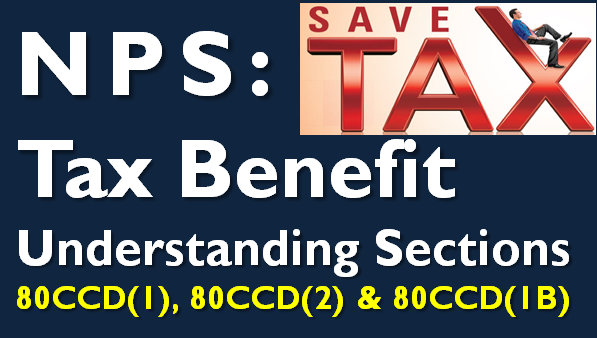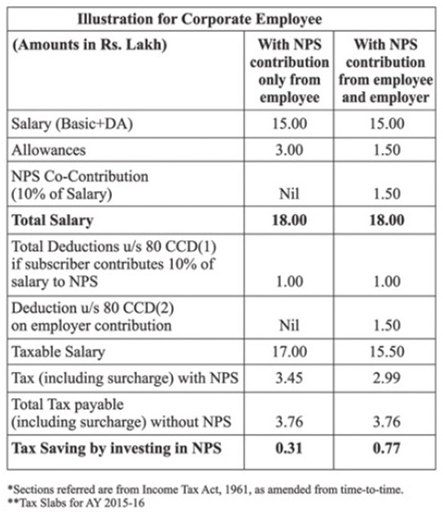In last few weeks I have got several mails and comments asking about the tax benefit on NPS. This post explains the tax deduction availa/ble for NPS under 3 sections: 80CCD(1), 80CCD(2) and 80CCD(1B).
Tax Benefit on NPS Tier 1 and/or 2?
NPS has two Tiers – 1 and 2.
NPS Tier 1 is the long term investment, which has restricted withdrawals and meant primarily for retirement planning. On maturity, you can withdraw maximum of 60% of corpus as lumpsum and rest has to be used for annuity purchase.
NPS Tier 2 is for managing short to medium term investment. You can invest and withdraw anytime as per your wish. This is an optional feature and you are asked if you need Tier 2 account while opening NPS.
All the tax benefit related to NPS is available to investment in NPS Tier 1 account only.
Also Read: When and How can Tax Benefits Claimed Earlier be Reversed?

NPS Tax Benefits:
NPS tax benefits are available through 3 sections – 80CCD(1), 80CCD(2) and 80CCD(1B). We discuss each below:
1. Section 80CCD(1)
Employee contribution up to 10% of basic salary and dearness allowance (DA) up to 1.5 lakh is eligible for tax deduction. [This contribution along with Sec 80C has 1.5 Lakh investment limit for tax deduction]. Self employed can also claim this tax benefit. However the limit is 10% of their annual income up to maximum of Rs 1.5 Lakhs.
2. Section 80CCD(1B)
Additional exemption up to Rs 50,000 in NPS is eligible for income tax deduction. This was introduced in Budget 2015.
Also Read: Should You invest in NPS to take tax benefit u/s 80CCD(1B)
3. Section 80CCD(2)
Employer’s contribution up to 10% of basic plus DA is eligible for deduction under this section above the Rs 1.5 lakh limit in Sec 80CCD(1). This is also beneficial for employer as it can claim tax benefit for its contribution by showing it as business expense in the profit and loss account. Self employed cannot claim this tax benefit.
Below is the illustration on how introducing NPS can help you save tax under Section 80CCD(2).

Tax Benefit for Compulsory NPS deduction:
The earlier pension structure was replaced by NPS in most central and state government jobs since 2004. So anyone who joined after that has compulsory deduction for NPS. The deduction is 10% of basic salary and dearness allowance (DA) and the employer too contributes the matching amount. The confusion for most employees is how they take tax benefit on their compulsory NPS deduction?
Here is an example:
Amit is a government employee and his employer deducts Rs 62,000 per annum (which is 10% of basic + DA) from salary as employee’s contribution in NPS. It also deposits Rs 62,000 per annum as employer’s contribution in NPS. How and under which section should he claim tax benefit on NPS?
Let’s take the easy part first. Employee’s contribution in NPS would be eligible for tax deduction u/s 80CCD(1).
The employee has a choice as to which section [80CCD(1) or 80CCD(1B)] he wants to show his contribution. Ideally he should show Rs 50,000 investment in NPS u/s 80CCD(1B). The tax deduction on rest Rs 12,000 can be claimed u/s 80CCD(1). The section 80CCD(1) along with Section 80C has investment limit eligible for tax deduction as Rs 1.5 lakhs. So he should make additional investment of Rs 1,38,000 in Section 80C to save maximum tax. In all he can save Rs 2 lakhs tax u/s 80C and 80CCD(1B).
I hope this would have cleared the confusion on how NPS helps you save tax.

Hi Amit Sir,
I am aware of Rs. 50000 exemption, from taxable income, under section 80ccd(1b).
Just wanted to know can government stop such exemption section any time?
Or there are provisions in constitution that such exemption should be followed for certain number of years.
Thanks
The exemption can be altered anytime and is done mostly in Budget every year. Also keep in mind the taxation of products keep on changing.
Hi,
I am a private sector employee with no contribution by employer in NPS. However I wish to invest in NPS. I have exhausted by 80C limit of 1.5 lakh, without considering the NPS Contribution. So if I contribute any amount in Tier1 account, can I claim that u/s 80CCD(1B) where I can get an additional benefit of 50k.
Kindly advise
yes
Hi Amit sir, what is difference between the fields “Income from salary/ pension (B1)” and “Income under salary i.e. Col(3) of Sch TDS1” of ITR-1? Are we supposed to fill the same amount at both these places?
Yes
Sir I have a another question that if 80c is over 1.5 lakh,then can I fill the difference amount in 80ccd(1b)?
In case you have invested in NPS you can choose to show tax exemption u/s 80CCD(1) part of 80C or 80CCD(1B)
dear sir i am working in PSB filled ITR for AY 2017-18 on 27 jun in that i have shown Rs 150000 under sec 80 which include EPF/PPF/SSA etc. i claimed relief under sec 80CCD(1b) for Rs 50000 my NPS contribution and under sec 80CCD2 Rs 66567 which is employer contribution to NPS but i got email from CPC regarding wrong adjustment and asking me to correct the deductions only Rs 150000 instead of Rs 270000 which i have shown due to NPS contribution. kindly guide
If you show employer contribution as exemption u/s 80CCD(2) then you also need to add the same to your income. The choice of exemption on your contribution to go with 80CCD(1) or 80CCD(1B) is with you. You can reply to the notice in this format.
In 80c total1.22 lakh,my 80ccd(1) is 58870 and govt contribution is same.I have a question that can I fill the NPS amounts in 80ccd(1b)?
You can take your contribution either in 80CCD(1) under sec 80C or under 80CCD(1B)
Sir,
I am a government employee. In my form 16 they have included HRA in taxable income. Can I take exemption on HRA after deducting it from gross income?
Yes you can claim HRA benefit while filing your ITR.
Sir, i m govt employee. in my form 16 employer contribution is not shown. but can i still claim it under 80ccd2
I recommend you to follow Form 16 – IF 80CCD(2) is NOT in Form 16 avoid it and vice-versa. In case you want to show it in ITR add that to your income and then deduct the same using Section 80CCD(2)
i have contributed rs.66260/- in nps & my employer also contributed the same. can i treat 16260/- u/s 80ccd(1) & balance rs. 50000/- in 80ccd(1B). My employer treated my contribution rs. 66260/- u/c 80 C in form 16
Yes you can
hi, amit sir, my nps deduction was 80 k by employer, they has contributed 80 k,
i has prepaid home loan principal of 4 lakhs so, it will be in 80c,
can i show 80 k in 80ccd1b, and 80 k in 80ccd2
Yes you can. But remember take exemption of 80CCD(2) only if employer contribution is added to your income
IF I AM A AUTO DRIVER AND I WANT TO RETURN MY FILE PL.CONVEY IN ITR-1 SECTION WHAT SECTION SHOULD I SELECT
I understand that as Auto-driver you are not salaried employee. So you’ll have to file income tax returns using ITR 3.
Hello sir, the employer contribution under section 80 CCD (2) has not been updated in my form 16. Can I file my return without that.
The Form 16 is correct…. its not required to be stated in Form 16
Sir,
In ITR 1 for AY 17-18 i have invested and reflected as under :-
u/s 80c rs 156501/- to be allowed rs 150000/- ppf in bank & lic.
U/s 80ccd (1) rs 12581/- deducted from salary as employee share of nps
u/s 80ccd(1b) = rs 37419/- deposited addl amt in nps
But in itr 1 i have also reflected rs 12581/-
against 80ccd(2) errorneously.
Now let me know how I correct my itr 1 either by filling under sec 139 (5). The amount of u/s 80ccd(1) can be merged with 80ccd(1b) & reflect total amt 50,000/- against 80ccd(1b).
I have recd notice from IT deptt u/s 143(1)(a) for savings as these amt not shown in form 16 issued by my employer. Only rs 12801/- as nps +gi reflected.
Please help me out to obviate from this problems.
Regards
Ratan Lal Sharma
Sir,
In ITR 1 for AY 17-18 i have invested and reflected as under :-
u/s 80c rs 156501/- to be allowed rs 150000/- ppf in bank & lic.
U/s 80ccd (1) rs 12581/- deducted from salary as employee share of nps
u/s 80ccd(1b) = rs 37419/- deposited addl amt in nps
But in itr 1 i have also reflected rs 12581/-
against 80ccd(2) errorneously.
Now let me know how I correct my itr 1 either by filling under sec 139 (5). The amount of u/s 80ccd(1) can be merged with 80ccd(1b) & reflect total amt 50,000/- against 80ccd(1b).
I have recd notice from IT deptt u/s 143(1)(a) for savings as these amt not shown in form 16 issued by my employer. Only rs 12801/- as nps +gi reflected.
Please help me out to obviate from this problems.
Regards
You can agree to the income tax notice – refer to our post on How to Respond to Notice u/s 143(1)(a)?. Also file a revised tax return after that correcting your error.
Sir,
My total gross salary for fy 2016-17 is 7,57,320/- which includes LTA, HRA, and conveyance allowance of 1,09,951/-
At the time of filing ITR should I fill Income From Salary column with total gross salary or should I deduct the amount of Rs. 1,09,951 from it.
Deduct the amount of 109951
I am working in a private sector. I am investing 1.5L per year under Sukanya Samridhi Yojana and hence entire 80C amount that can be used for tax relief is used up. On top of it I am contributing 50K per year into my personal NPS account. My present employer doesn’t have any tie up with NSDL yet, but if it registers and contributes into my NPS account through corporate NPS scheme, can I claim additional tax benefit of 10% of basic? E.g. if my basic is 1.1L pm, would I be eligible to save total tax of 2L+1.32L? Or is there a cap on total saving e.e. maximum 2L or 2.5L?
If your employer also contributes it would be additional tax exemption of 10% of basic. There is No cap on the same.
Hello sir,
I have a joint home development loan in the name of my father & me. Property in the name of my father but the EMI of home loan is to be paid by me from my saving account. Can I claim the benefit of Principal amount and Interest Paid under my e filing. If yes then, my total saving become Rs. 216250/- (including Principal amount of Rs. 50137/- & NPS Rs. 65219/-). So can I claim benefit of my saving (216250-65219NPS=151031) under 80 C upto 150000/- and rest NPS of Rs. 65219 under 80CCD(1B) upto 50000/-. My department is not showing in form -16 the benefit of Home Loan. My total taxable Income is 719720/- which attracted the tax Rs. 40120/-. So Can I claim the further tax benefit through refund. Please guide me properly. I shall be very thankful to you.
To take exemption on home loan, the property should be in your name (singly or jointly). As its only on your father’s name you cannot take tax benefit either on interest or principal amount on home loan!